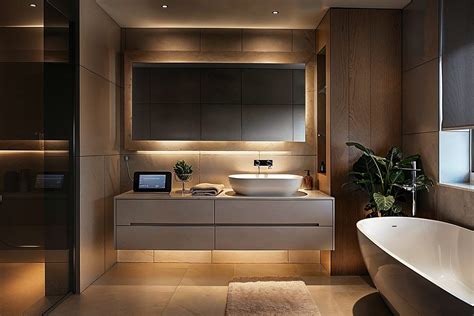
Mike Holmes, the renowned home improvement expert, is cautioning homeowners against prioritizing aesthetics over functionality in bathroom design, specifically addressing trendy features that may compromise long-term practicality and value. Holmes argues that while visually appealing, certain contemporary bathroom trends often neglect crucial elements like proper ventilation, waterproofing, and durable materials, leading to potential problems such as mold growth, structural damage, and costly repairs down the line. He emphasizes the importance of a balanced approach that combines style with sound construction principles to ensure a bathroom is both beautiful and built to last.
Holmes’s critique centers on the potential pitfalls of blindly following design fads without considering the underlying infrastructure. He asserts that many modern bathroom designs, while visually striking, lack the fundamental elements necessary for a bathroom to withstand the daily rigors of moisture, humidity, and heavy use. This oversight, he warns, can result in significant issues that detract from the home’s value and necessitate extensive and expensive remediation.
According to Holmes, the allure of quick and inexpensive renovations often leads homeowners to compromise on quality. He urges individuals to view bathroom renovations as long-term investments, emphasizing the importance of selecting durable, water-resistant materials and hiring qualified professionals who understand the intricacies of bathroom construction. This approach, he believes, will ultimately save homeowners money and prevent future headaches.
One of Holmes’s primary concerns is the inadequate ventilation in many modern bathrooms. He stresses the critical role of proper ventilation in removing moisture and preventing mold growth. Bathrooms are inherently humid environments, and without adequate ventilation, moisture can accumulate on surfaces, creating a breeding ground for mold and mildew. This not only poses a health risk but can also damage walls, ceilings, and other structural components. Holmes recommends installing high-quality exhaust fans that effectively remove moisture and ensuring that ventilation systems are properly maintained.
Another area of concern for Holmes is the use of inappropriate materials in bathroom renovations. He cautions against using materials that are not specifically designed for wet environments, such as certain types of wood or porous tiles. These materials can absorb moisture, leading to swelling, warping, and eventual failure. Holmes advises homeowners to opt for water-resistant materials like porcelain or ceramic tile, waterproof membranes, and moisture-resistant drywall.
Holmes also highlights the importance of proper waterproofing in bathroom construction. He emphasizes that waterproofing is not merely a surface treatment but a comprehensive system that protects the underlying structure from water damage. This includes applying waterproof membranes to floors, walls, and shower enclosures, as well as properly sealing joints and seams. Holmes warns that inadequate waterproofing can lead to water leaks, which can damage surrounding walls, floors, and ceilings.
Beyond the technical aspects of bathroom construction, Holmes also addresses the aesthetic choices that can impact the long-term functionality and value of a bathroom. He cautions against over-the-top designs that may quickly become dated or impractical. Holmes suggests opting for timeless designs that are both functional and aesthetically pleasing. This includes choosing classic fixtures, neutral color palettes, and durable finishes.
Holmes encourages homeowners to prioritize functionality over fleeting trends. He advises individuals to consider their lifestyle and needs when designing a bathroom. For example, families with young children may require a different type of bathroom than empty-nesters. Holmes also stresses the importance of accessibility, suggesting that homeowners incorporate features that make the bathroom easier to use for people of all ages and abilities.
In addition to his warnings about trendy bathroom designs, Holmes also offers practical advice for homeowners considering a bathroom renovation. He recommends starting with a detailed plan that outlines the scope of the project, the budget, and the desired outcome. Holmes also advises homeowners to obtain multiple bids from qualified contractors and to check their references. He stresses the importance of hiring a contractor who is licensed, insured, and experienced in bathroom renovations.
Holmes’s message is clear: a well-designed bathroom should be both beautiful and functional. By prioritizing quality materials, proper construction techniques, and timeless designs, homeowners can create bathrooms that are not only aesthetically pleasing but also built to last. This approach, he believes, will ultimately enhance the value of the home and provide years of enjoyment.
Holmes’s expertise stems from decades of experience in the home improvement industry. He has witnessed firsthand the consequences of poor construction practices and inadequate maintenance. Through his television shows and educational initiatives, Holmes has dedicated his career to educating homeowners about the importance of quality craftsmanship and responsible homeownership. His critique of trendy bathroom designs is a continuation of this mission, aimed at empowering homeowners to make informed decisions and avoid costly mistakes.
The increasing popularity of home renovation shows and social media platforms has contributed to the rise of bathroom trends. Homeowners are constantly bombarded with images of stylish bathrooms, often without a clear understanding of the underlying construction requirements. This can lead to unrealistic expectations and a willingness to sacrifice quality for aesthetics. Holmes’s intervention serves as a reminder that bathroom renovations are complex projects that require careful planning and execution.
Furthermore, the desire to increase home value often drives homeowners to undertake bathroom renovations. While a well-designed bathroom can certainly enhance a home’s appeal, Holmes cautions against focusing solely on cosmetic improvements. He argues that a poorly constructed bathroom can actually detract from a home’s value, as potential buyers may be wary of the potential problems lurking beneath the surface. Therefore, it is essential to prioritize quality and durability over superficial aesthetics.
Holmes’s perspective is particularly relevant in today’s market, where homeowners are increasingly seeking sustainable and eco-friendly options. He encourages homeowners to choose materials and fixtures that are both durable and environmentally responsible. This includes selecting low-flow toilets, water-efficient showerheads, and recycled or reclaimed materials. By making sustainable choices, homeowners can reduce their environmental impact and create bathrooms that are both beautiful and eco-friendly.
In conclusion, Mike Holmes’s critique of trendy bathroom designs serves as a valuable reminder of the importance of prioritizing functionality and quality over fleeting aesthetics. By focusing on proper ventilation, waterproofing, durable materials, and sound construction techniques, homeowners can create bathrooms that are not only visually appealing but also built to last. This approach will ultimately enhance the value of the home and provide years of enjoyment. Holmes’s message is a call to action for homeowners to become more informed consumers and to demand quality craftsmanship in all aspects of their home renovations. His perspective reinforces the need for a balanced approach that combines style with substance, ensuring that bathrooms are both beautiful and built to withstand the test of time.
The conversation surrounding bathroom renovations often revolves around cost-effectiveness and maximizing visual appeal, sometimes at the expense of crucial structural and functional considerations. Holmes’s insights are a vital counterpoint to the pervasive emphasis on trends, urging homeowners to critically evaluate the long-term implications of their design choices. His expertise offers a necessary dose of realism, highlighting the potential pitfalls of prioritizing short-term gratification over lasting value and safety. By advocating for informed decision-making and responsible construction practices, Holmes empowers homeowners to create spaces that are not only beautiful but also resilient and reliable. His commitment to quality craftsmanship and consumer education is a testament to his dedication to promoting responsible homeownership and ensuring that homes are built to stand the test of time.
The current trend of DIY renovations, fueled by readily available online tutorials and the desire to save money, further underscores the importance of Holmes’s message. While DIY projects can be rewarding, bathroom renovations often involve complex plumbing, electrical, and structural considerations that are best left to qualified professionals. Attempting to cut corners or relying on inadequate knowledge can lead to costly mistakes and potentially dangerous situations. Holmes’s emphasis on hiring licensed and experienced contractors is a crucial reminder that bathroom renovations are not always a DIY-friendly endeavor.
The long-term benefits of prioritizing quality and functionality in bathroom design extend beyond mere aesthetics and cost savings. A well-designed and properly constructed bathroom can contribute to a healthier living environment by minimizing the risk of mold growth and water damage. It can also enhance the overall comfort and convenience of the home, making it a more enjoyable place to live. Furthermore, a durable and functional bathroom can increase the resale value of the home, making it a worthwhile investment in the long run.
The impact of Holmes’s message is particularly significant in light of the growing awareness of environmental sustainability. By advocating for the use of eco-friendly materials and water-efficient fixtures, Holmes encourages homeowners to create bathrooms that are not only beautiful and functional but also environmentally responsible. This aligns with the broader trend of sustainable living and contributes to a more environmentally conscious approach to homeownership.
Mike Holmes’s intervention is not just a critique of current trends; it is a comprehensive guide to responsible bathroom renovation. He advocates for a holistic approach that considers not only the visual appeal but also the structural integrity, functionality, and environmental impact of the design. By following his advice, homeowners can avoid costly mistakes, create healthier living environments, and enhance the long-term value of their homes. Holmes’s message is a powerful reminder that quality craftsmanship and informed decision-making are essential ingredients for successful and sustainable homeownership.
His emphasis on preventative measures, such as proper ventilation and waterproofing, underscores the importance of addressing potential problems before they arise. By investing in these crucial elements, homeowners can avoid costly repairs and maintain the integrity of their homes for years to come. Holmes’s advocacy for quality craftsmanship and durable materials is a call to action for homeowners to demand excellence in all aspects of their home renovations.
The influence of social media on bathroom design trends cannot be overstated. Platforms like Instagram and Pinterest showcase a constant stream of visually stunning bathrooms, often featuring impractical or unsustainable designs. This can create a sense of pressure for homeowners to emulate these trends, even if they are not suitable for their lifestyle or budget. Holmes’s message serves as a counterweight to this influence, encouraging homeowners to prioritize their own needs and preferences over fleeting trends.
His commitment to consumer education is evident in his efforts to provide homeowners with the knowledge and resources they need to make informed decisions. Through his television shows, books, and online platforms, Holmes empowers homeowners to become active participants in the renovation process, ensuring that their projects are executed to the highest standards of quality and craftsmanship.
The economic implications of Holmes’s message are also significant. By advocating for durable materials and proper construction techniques, he helps homeowners avoid costly repairs and replacements in the long run. This can save homeowners thousands of dollars and prevent unnecessary stress and inconvenience. Holmes’s emphasis on long-term value is a crucial reminder that home renovations are an investment, and that it is essential to prioritize quality and durability over short-term savings.
Mike Holmes’s perspective is particularly valuable in the context of the aging housing stock in many parts of the world. As homes age, they become more susceptible to problems like water damage, mold growth, and structural issues. Holmes’s advice on proper ventilation, waterproofing, and durable materials is essential for maintaining the integrity of these homes and preventing costly repairs. His message is a call to action for homeowners to invest in the upkeep and maintenance of their homes, ensuring that they remain safe, healthy, and functional for years to come.
The holistic approach advocated by Mike Holmes extends beyond the technical aspects of bathroom renovation. He also emphasizes the importance of considering the overall design and functionality of the space. This includes factors like lighting, storage, and accessibility. By carefully planning these elements, homeowners can create bathrooms that are not only beautiful and durable but also comfortable and convenient to use.
Holmes’s influence on the home improvement industry is undeniable. He has inspired countless homeowners to take a more responsible and proactive approach to home renovation and maintenance. His commitment to quality craftsmanship and consumer education has helped to raise the standards of the industry and empower homeowners to demand excellence in all aspects of their home improvement projects.
In conclusion, Mike Holmes’s critique of trendy bathroom designs is a vital contribution to the ongoing conversation about responsible homeownership. His message is a powerful reminder that quality, functionality, and sustainability should be prioritized over fleeting aesthetics. By following his advice, homeowners can create bathrooms that are not only beautiful but also built to last, enhancing the value of their homes and providing years of enjoyment. Holmes’s commitment to consumer education and quality craftsmanship is a testament to his dedication to promoting responsible homeownership and ensuring that homes are built to stand the test of time. Frequently Asked Questions (FAQs):
1. What is Mike Holmes’s main concern regarding current bathroom design trends?
- Answer: Mike Holmes’s main concern is that many current bathroom design trends prioritize style over substance, neglecting essential functional aspects like proper ventilation, waterproofing, and the use of durable materials. This can lead to issues such as mold growth, structural damage, and costly repairs. As Holmes stated, homeowners often “compromise on quality” in pursuit of quick and inexpensive renovations.
2. What specific aspects of bathroom construction does Holmes emphasize as being frequently overlooked?
- Answer: Holmes emphasizes the importance of proper ventilation to remove moisture and prevent mold, the use of water-resistant materials designed for wet environments (such as porcelain or ceramic tile instead of wood), and comprehensive waterproofing systems to protect the underlying structure from water damage. He also cautions against designs that may become quickly dated.
3. What advice does Holmes offer for homeowners planning a bathroom renovation?
- Answer: Holmes advises homeowners to start with a detailed plan outlining the project’s scope, budget, and desired outcome. He recommends obtaining multiple bids from qualified, licensed, and insured contractors and checking their references. He stresses the importance of hiring professionals experienced in bathroom renovations to ensure quality craftsmanship.
4. How does Holmes believe homeowners can balance aesthetics with functionality in bathroom design?
- Answer: Holmes suggests opting for timeless designs, neutral color palettes, and durable finishes that are both functional and aesthetically pleasing. He encourages homeowners to consider their lifestyle and needs when designing a bathroom, and to incorporate accessibility features for people of all ages and abilities. He believes a well-designed bathroom should be both beautiful and functional.
5. Why is Holmes critical of the influence of home renovation shows and social media on bathroom design trends?
- Answer: Holmes is critical because these platforms often showcase stylish bathrooms without providing a clear understanding of the underlying construction requirements. This can lead to unrealistic expectations and a willingness to sacrifice quality for aesthetics. He believes this can result in poorly constructed bathrooms that detract from a home’s value due to potential problems.









